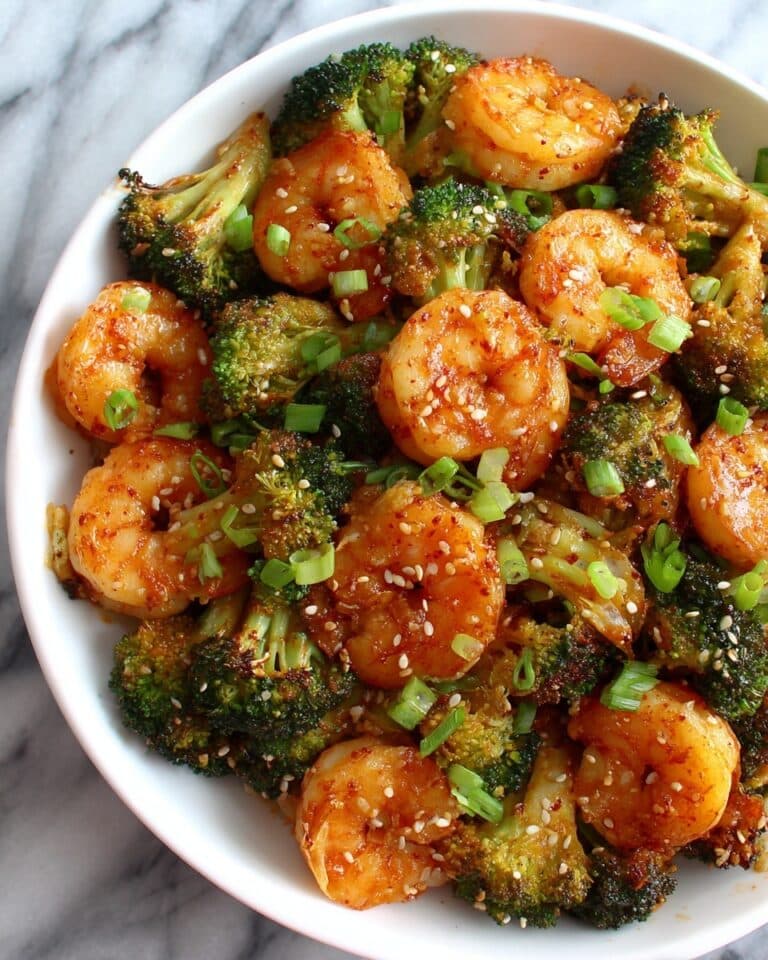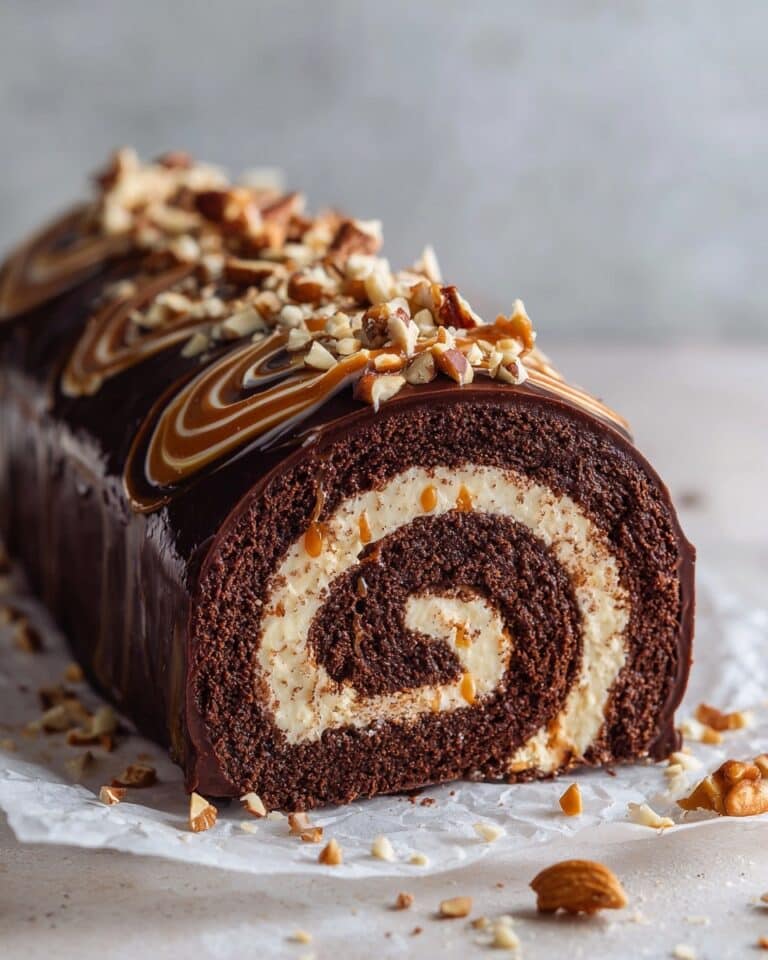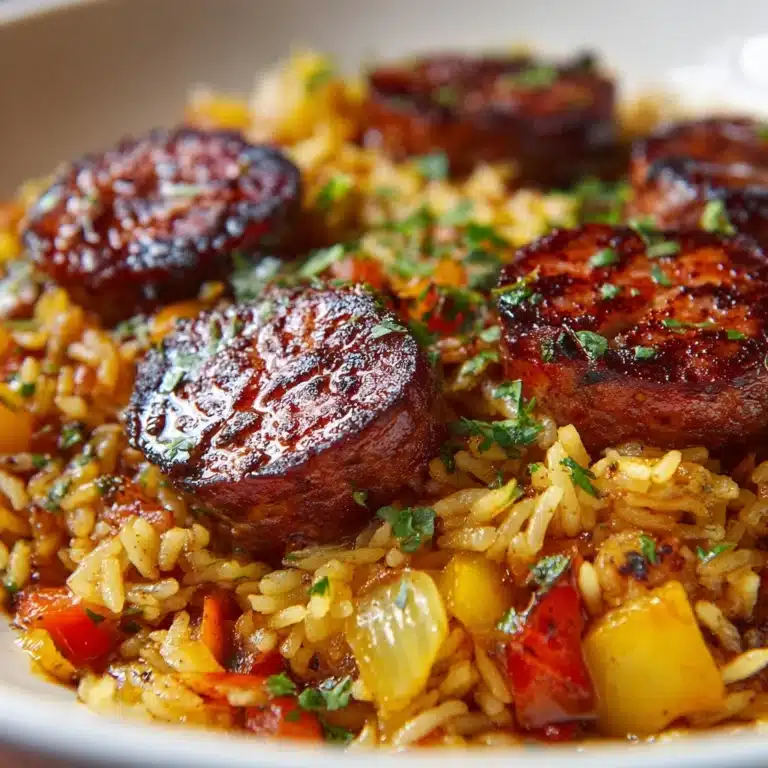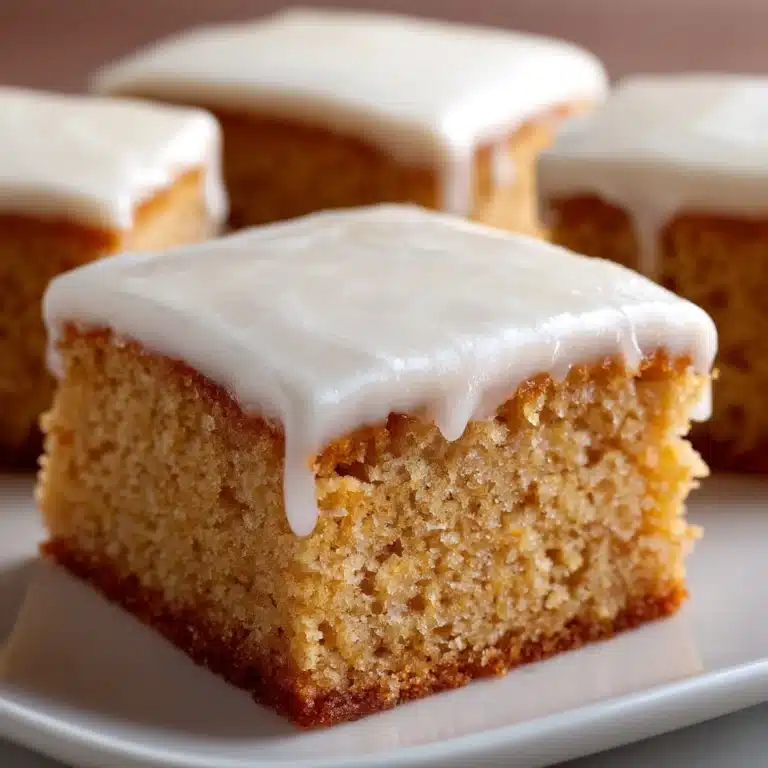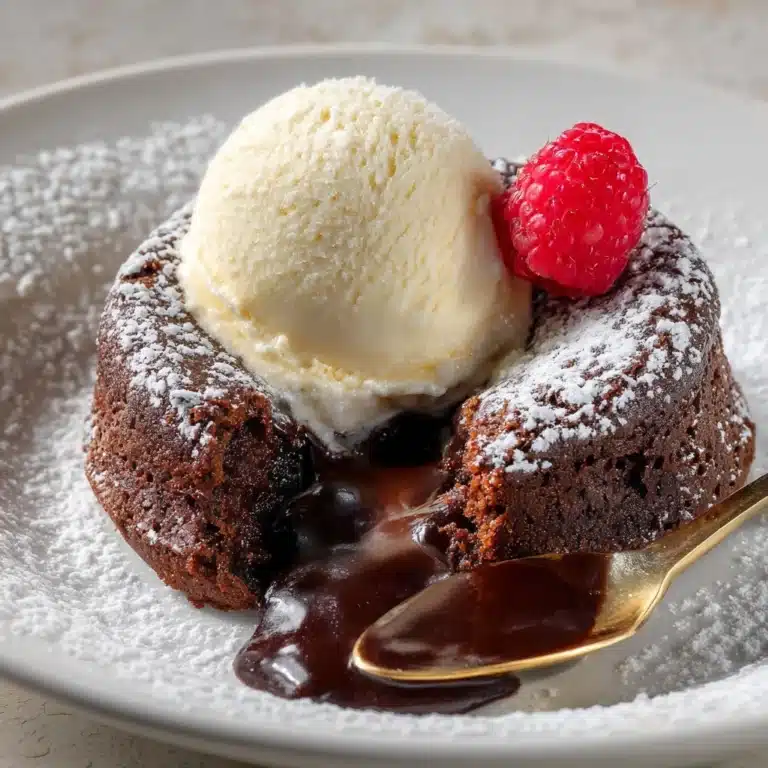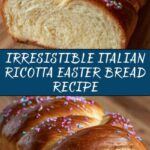Italian Ricotta Easter Bread Recipe
If you’re looking to add a burst of color and true Italian flair to your springtime table, Italian Ricotta Easter Bread is the answer. This beautiful, lightly sweet braided loaf, adorned with playful sprinkles and sometimes brilliant colored eggs, is a beloved treat at Italian Easter celebrations. Fluffy from ricotta and tender with butter and eggs, each slice tastes like a celebration—delicate citrus notes, a hint of almond, and a buttery crumb you’ll want to enjoy with a cup of coffee all through spring.
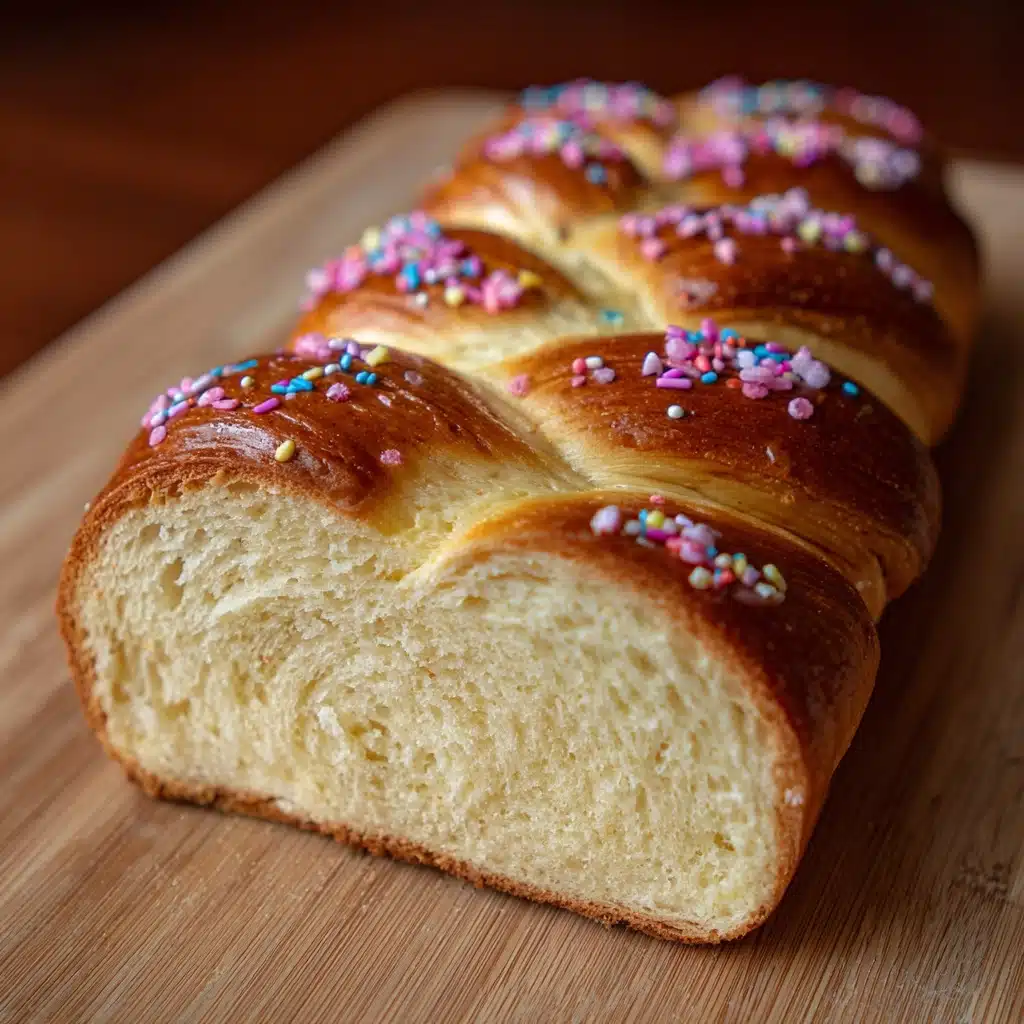
Ingredients You’ll Need
Just a handful of vibrant, straightforward ingredients go into Italian Ricotta Easter Bread, and each plays a starring role in building the bread’s distinct texture, color, and flavor. Don’t skip any—you’ll be richly rewarded with every bite.
- All-purpose flour: The foundation of the bread, providing structure while remaining soft for that perfect Easter loaf.
- Active dry yeast: The powerhouse behind the bread’s beautiful rise, giving it that traditional, fluffy texture.
- Warm milk: Warmth helps activate the yeast and adds subtle richness to the dough.
- Granulated sugar: Just enough to create a gentle sweetness—this is not an overly sweet bread, but perfectly balanced.
- Salt: A little salt sharpens all the flavors and ensures your bread isn’t flat or bland.
- Large eggs: Essential for flavor, moisture, and the beautiful golden crumb typical of Italian holiday breads.
- Ricotta cheese: Whole-milk ricotta is best here because it adds a tender, almost creamy crumb you won’t get from other ingredients.
- Unsalted butter: Softened butter gives the loaf a rich, melt-in-your-mouth texture.
- Vanilla extract: Adds a subtle, sweet floral aroma that elevates every bite.
- Almond extract (optional): Just a half teaspoon brings a wonderful depth and a hint of nutty flavor—highly recommended!
- Zest of 1 lemon: Grating fresh lemon zest right into the dough makes the bread impossibly fragrant and bright.
- Ground nutmeg: A sprinkle of nutmeg offers warm undertones without overpowering the loaf.
- Egg (for wash): This gives your bread its glistening, golden crust—don’t skip the egg wash!
- Colored sprinkles: The finishing touch; these create the joyful, celebratory look that Italian Ricotta Easter Bread is famous for.
- Raw dyed Easter eggs (optional): For a traditional look, tuck these between the braids—they’ll cook beautifully in the oven.
How to Make Italian Ricotta Easter Bread
Step 1: Bloom the Yeast
Begin by dissolving the active dry yeast in warm milk with just a pinch of sugar. Let this bubbly mixture sit for 5 to 10 minutes until the surface is foamy—this is your sign the yeast is alive and ready to work its magic. It’s always a little exciting to see those bubbles and know a delicious loaf is on its way!
Step 2: Mix the Dry Ingredients
In a large mixing bowl (or the bowl of your trusty stand mixer), combine the flour, granulated sugar, salt, lemon zest, and a sprinkle of ground nutmeg. Stirring these together first ensures the flavors are evenly distributed, so every bite of your Italian Ricotta Easter Bread captures just the right balance.
Step 3: Whisk the Wet Ingredients
In a separate bowl, whisk up your eggs, ricotta, softened butter, vanilla extract, and a splash of almond extract if you’re using it. This creamy, velvety mixture will give your bread that signature softness as well as a rich, subtly sweet taste.
Step 4: Combine and Knead the Dough
Add the foamy yeast mixture to your wet ingredients and stir to combine. Gradually add these wet ingredients to your dry mixture, working gently until a soft dough starts to come together. Knead the dough by hand or using your mixer’s dough hook for 8 to 10 minutes—the goal is a smooth, elastic, slightly tacky dough. Add a little extra flour if it’s stubbornly sticky, but remember: a soft dough makes tender Italian Ricotta Easter Bread!
Step 5: First Rise
Shape your dough into a loose ball and set it in a greased bowl, turning it over once so the top is lightly coated. Cover with plastic wrap or a clean towel, and let it rise in a warm spot until doubled—this usually takes 1 1/2 to 2 hours. When the dough is puffed and pillowy, you know it’s ready for the fun part.
Step 6: Shape and Braid
Punch down the dough and divide it into three equal pieces. Roll each piece into a rope about 18 inches long. Gently braid the ropes together and shape them into a round ring or leave the braid straight if you prefer. For the classic look, nestle 3 to 6 colored, raw (yet safe-to-bake) Easter eggs gently between the braids.
Step 7: Second Rise
Transfer your braided masterpiece to a parchment-lined baking sheet. Cover loosely and let rise again for 30 to 45 minutes, just until they look plump and almost doubled. This will ensure your Italian Ricotta Easter Bread bakes up extra airy.
Step 8: Bake and Decorate
Preheat your oven to 350°F. Brush the top of the risen loaf with whisked egg to create a glossy golden finish, and scatter on plenty of bright, cheerful sprinkles. Bake for 30 to 35 minutes until the bread is golden brown and sounds hollow when tapped. Let the bread cool completely before slicing so that the crumb stays tender and intact.
How to Serve Italian Ricotta Easter Bread
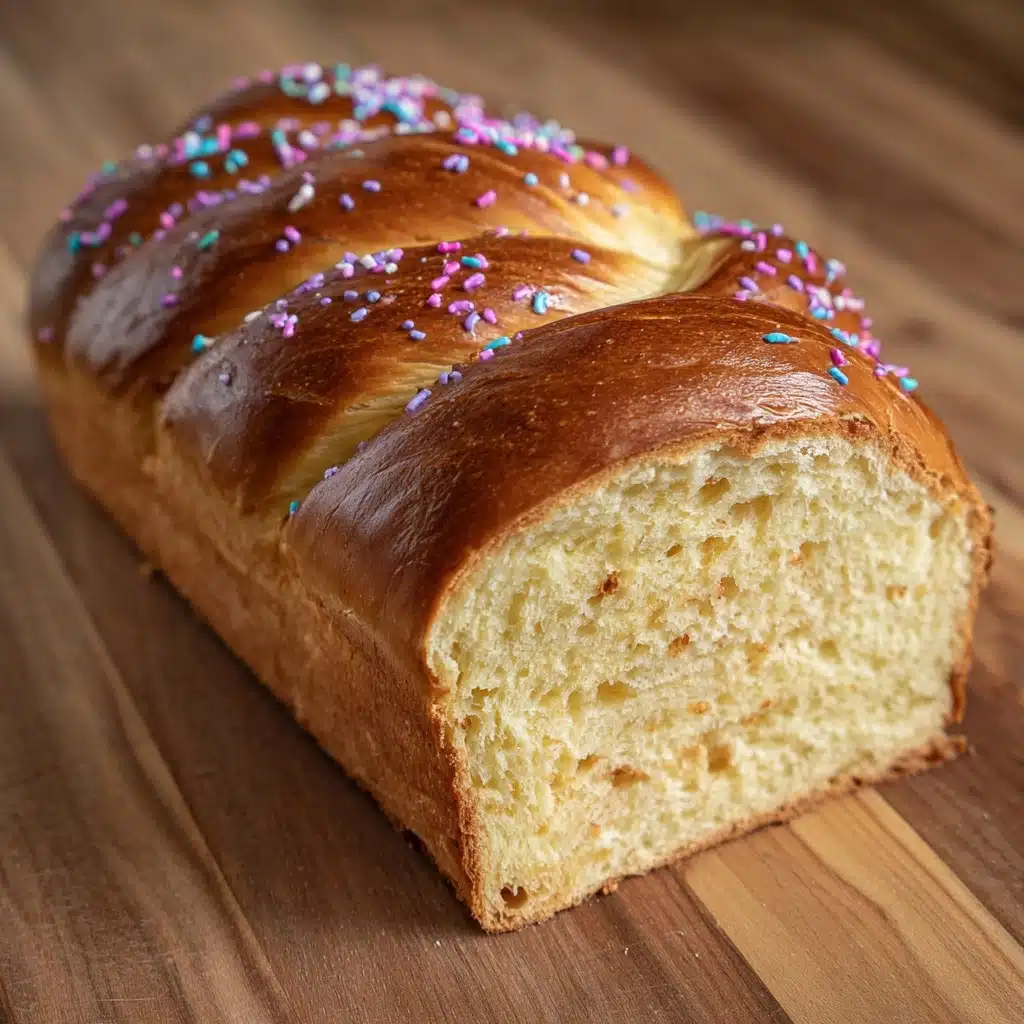
Garnishes
On the table, this bread needs little extra—classic colored sprinkles and the option of jeweled eggs make Italian Ricotta Easter Bread the star. But for a pretty touch, try a dusting of powdered sugar or a drizzle of sweet glaze if you’re feeling festive!
Side Dishes
The bread shines brightest alongside a hot cup of strong coffee, espresso, or a fragrant black or herbal tea. For a savory spread, serve with whipped salted butter, fruit preserves, or even sweetened ricotta. If you’re hosting a full brunch, pair with fresh fruit salads, soft cheeses, frittatas, or lemony roasted asparagus.
Creative Ways to Present
For a showstopper, arrange your Italian Ricotta Easter Bread in the center of your holiday table as a vibrant centerpiece—those sprinkles and pastel eggs make it irresistible! Wrap slices in parchment as edible gifts, or transform leftovers into sweet French toast the next morning. Tucking in a card with a family recipe or a sprig of spring herbs makes it even more memorable.
Make Ahead and Storage
Storing Leftovers
If by some miracle there’s bread leftover, wrap it tightly in plastic wrap or foil, then store at room temperature for up to 2 days. The ricotta keeps the crumb moist and tender, so you’ll enjoy slices even on day two. Avoid refrigerating, as it can quickly dry out this lovely bread.
Freezing
Want to savor the celebration a little longer? Italian Ricotta Easter Bread freezes beautifully. Once completely cooled, wrap slices or the entire loaf tightly in plastic wrap and then in foil. Freeze for up to one month. Thaw overnight at room temperature, and it will taste bakery-fresh!
Reheating
To gently bring the bread back to life, warm slices in a toaster oven or regular oven at 300°F for 5 to 8 minutes. If you prefer, add a pat of butter before warming for extra decadence. The light aroma will fill your kitchen once again, making leftovers just as tempting as the first slice.
FAQs
Can I make Italian Ricotta Easter Bread without dyed eggs?
Absolutely! The colorful eggs are traditional but totally optional. Your bread will be just as delicious—and perhaps a bit easier to slice and share. If you want the look, you can always add decorative (not baked) eggs after baking.
What’s the secret to a really fluffy Italian Ricotta Easter Bread?
The trick is fresh yeast, a soft, hydrated dough, and not rushing the rise times. Ricotta cheese is also key—it keeps the crumb moist and oddly luxurious!
Can I make the dough ahead and bake the next day?
Yes! After your first rise and shaping, cover and refrigerate the dough overnight. Let it come to room temperature and finish its second rise before baking—perfect for a busy holiday morning.
What if I don’t have almond extract?
No worries! Almond extract adds a lovely nuance, but your Italian Ricotta Easter Bread will still be fragrant and delicious with just vanilla extract, lemon zest, and nutmeg.
Can I use part-skim ricotta or another cheese?
Whole milk ricotta is best for the richness and creamy crumb, but part-skim will work in a pinch. Avoid swapping in other cheeses, as the flavor and texture simply won’t be the same as traditional Italian Ricotta Easter Bread.
Final Thoughts
I truly hope you’ll give Italian Ricotta Easter Bread a try this season! Whether you’re keeping family traditions alive or starting new ones, this sweet, stunning loaf is all about togetherness and joyful sharing. One slice and you’ll see: it’s as beautiful to eat as it is to serve. Happy baking—and happy Easter!
Print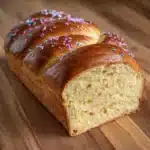
Italian Ricotta Easter Bread Recipe
- Total Time: 3 hours
- Yield: 1 large braided loaf 1x
- Diet: Vegetarian
Description
Celebrate Easter with this delightful Italian Ricotta Easter Bread. A sweet, braided loaf with a hint of citrus and nutmeg, adorned with colorful sprinkles and optional dyed Easter eggs for a festive touch.
Ingredients
Dough:
- 3 1/2 cups all-purpose flour (plus more as needed)
- 1 packet (2 1/4 teaspoons) active dry yeast
- 1/2 cup warm milk (about 110°F)
- 1/4 cup granulated sugar
- 1/2 teaspoon salt
Wet Mixture:
- 3 large eggs (room temperature)
- 1/2 cup ricotta cheese (whole milk preferred)
- 1/4 cup unsalted butter (softened)
- 1 teaspoon vanilla extract
- 1/2 teaspoon almond extract (optional)
- zest of 1 lemon
- 1/2 teaspoon ground nutmeg
Additional:
- 1 egg (for egg wash)
- colored sprinkles (for decoration)
- 3–6 raw dyed Easter eggs (optional, for traditional presentation)
Instructions
- Dissolve the yeast: In a small bowl, dissolve the yeast in the warm milk with a pinch of sugar and let sit for 5–10 minutes until foamy.
- Mix the dough: In a large mixing bowl, combine flour, sugar, salt, lemon zest, and nutmeg. In another bowl, whisk together eggs, ricotta, butter, vanilla, and almond extract. Add the yeast mixture to the wet ingredients and combine. Gradually add the wet mixture to the dry ingredients, kneading until a soft dough forms.
- Rise and braid: Let the dough rise until doubled in size. Divide and braid the dough, adding dyed eggs if desired. Let rise again, then brush with egg wash and sprinkles.
- Bake: Bake at 350°F for 30–35 minutes until golden brown. Cool before serving.
Notes
- The dyed eggs are safe to bake with and will cook in the oven.
- You can omit the dyed eggs for a simpler version.
- This bread pairs wonderfully with coffee or tea.
- Prep Time: 25 minutes
- Cook Time: 35 minutes
- Category: Bread
- Method: Baking
- Cuisine: Italian
Nutrition
- Serving Size: 1 slice (1/10 of loaf)
- Calories: 280
- Sugar: 7g
- Sodium: 190mg
- Fat: 10g
- Saturated Fat: 5g
- Unsaturated Fat: 4g
- Trans Fat: 0g
- Carbohydrates: 38g
- Fiber: 1g
- Protein: 7g
- Cholesterol: 75mg
